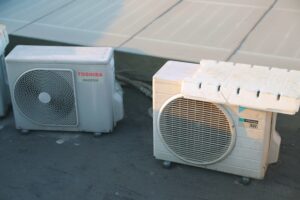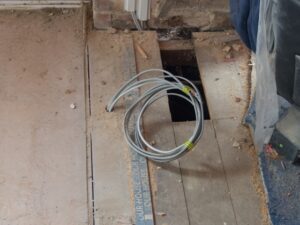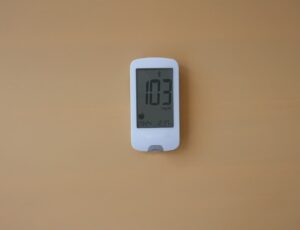Ever find yourself in a hot room, desperately searching for your air conditioner remote, only to realize it’s either missing or broken?
We’ve all been there, and it’s frustrating! But here’s the good news: you don’t need that remote to enjoy a cool breeze. The secret is knowing where to look and what buttons to press on your AC unit itself.
Most air conditioners come with a hidden manual power button—sometimes tucked behind a small panel or flap on the front of the unit. All you need to do is find it and press it. It’s as simple as that!
And if you’re lucky enough to have a Wi-Fi-enabled AC, you can control it from your smartphone. Yes, you read that right! You can manage your cooling settings with just a few taps on your phone. Just check your user manual to see if your AC model supports this feature, and voilà—remote control from anywhere in the house!
At Excel Mechanical, we understand how critical it is to stay cool, whether you’re at home or running a business. That’s why our expert team is here to help with tailored, quality HVAC solutions that fit your needs—and your budget.
In this blog, we’ll walk you through:
- How to quickly locate the manual control options on your AC unit.
- The simple technique of power cycling your unit if the manual controls don’t work.
- Alternative methods to control your AC, from smart devices to mobile apps, for those who want the ultimate convenience.
Let’s get started!
Understanding Your AC Unit
Knowing your AC unit is key to effectively managing its functionality without a remote.
This includes familiarizing yourself with the types of AC systems and understanding the manual control options available for these systems.
Types of AC Systems
There are several types of AC systems, each with unique features and functions.
- Central air conditioning uses a network of ducts to cool an entire building and is controlled from a central location.
- Ductless mini-split systems are helpful in cooling specific rooms and offer flexibility without needing ducts.
- Window units are self-contained systems installed in windows and are suitable for cooling individual rooms.
- Portable units can be moved from room to room.
- Finally, hybrid systems combine gas and electric power for energy efficiency.
Understanding these systems will help you determine which one you have and how to operate it.
Manual Control Options
Without a remote, using manual controls can help you operate your AC.
Most units have a control panel with power, temperature, and mode settings buttons. For central systems, you can adjust the temperature using a wall-mounted thermostat. Window and portable units typically have control panels that allow you to change settings directly on the unit.
Some AC systems have buttons for specific modes like fan or dry mode. Without manual options, consider consulting a professional for advice on alternatives.
Alternative Activation Methods
There are a few ways to turn on your AC without a remote.
These include using the AC panel buttons or power cycling the unit. Both methods allow you to regain functionality without a remote.
AC Panel Buttons
Many air conditioning units have control panels with buttons directly on the unit. You can use these buttons to turn the AC on or change settings. Look for buttons labeled “Power” on the panel. Press this button to activate the unit.
Sometimes, you might also see specific mode buttons, like “Cool” or “Fan.” Use them to adjust settings. These buttons allow you to manage the unit’s basic functions. They are a simple solution when the remote is unavailable.
Power Cycling the Unit
- Power cycling involves turning the main power supply to the AC unit off and back on.
- Locate the dedicated power switch or a circuit breaker associated with the unit.
- Turn it off for a few minutes, then switch it back on.
This process often resets internal settings and can kick-start the system. It’s a valuable technique if panel buttons aren’t working. After cycling power, you should notice the unit starting up.
Accessibility Options
There are several ways to control your air conditioner without a remote. You can use smart home devices or mobile apps to adjust the settings of your AC unit easily.
Using Smart Home Devices
Smart home devices offer a convenient way to manage your AC without a remote.
You can connect your air conditioner to smart assistants, like Amazon Alexa or Google Assistant. With these, you can use voice commands to turn your AC on or off and adjust the temperature.
Setting up this option often requires a compatible smart plug or hub. Once connected, you can control your AC with simple spoken instructions. This method is especially helpful for anyone looking for hands-free operation and ease of use.
Excel Mechanical recommends using smart home technology for its seamless integration and user-friendly nature. Our team can advise on choosing the right smart devices to connect with your existing HVAC setup.
Mobile Apps for AC Control
Many air conditioning brands now have mobile apps to control their units. These apps allow you to manage your AC using your smartphone or tablet. Key functions include changing temperatures, timer settings, and modes.
Download the app corresponding to your AC brand to use this option. After installation, follow the pairing instructions to sync your device with the AC unit. This gives you remote management, even when you’re not at home.
Troubleshooting Common Issues
If you try to operate your AC without a remote, you may encounter some common issues. This guide addresses problems like non-responsive buttons and power failures.
AC Doesn’t Respond to Buttons
If the AC doesn’t react when you press buttons, there might be a simple cause.
- First, ensure the control panel buttons aren’t locked.
- Refer to your AC’s manual to learn how to unlock them.
- Check for dirt or debris around the control panel. Dust can prevent proper contact with the buttons.
- Use a soft cloth to clean the surface carefully.
- Consider resetting the AC. Many units have a reset button on the control panel or near the main unit. Pressing it can resolve minor glitches.
If these steps fail, consulting professionals can provide deeper insight and solutions. They excel in HVAC services and can tailor solutions to specific units.
When the AC Unit Won’t Power On
When an AC unit won’t turn on, start by checking the power supply.
Make sure the unit is plugged in securely. Inspect the circuit breaker and reset it if it’s tripped. Examine the power cord for damage. A frayed or broken cord should be replaced immediately to avoid hazards.
If the unit still doesn’t power on, internal issues such as a blown fuse might be the problem. In such cases, having an expert inspect it ensures professional service aimed at quality and efficiency for both residential and commercial needs. They focus on delivering the most suitable solution within your budget.
Professional Assistance
Seeking help from professionals like Excel Mechanical can ensure your AC system works efficiently. Our expertise can diagnose issues and provide tailored solutions for your needs and budget. Learn when to call a technician and what to expect during a service visit.
When to Call a Technician
If your AC does not respond to manual controls, contact a professional technician. Strange noises, leaks, or unpleasant smells are signs that something is wrong. If you notice these, it’s best not to delay.
Excel Mechanical offers reliable HVAC and plumbing services tailored to homes and businesses. We can assess your situation, provide solutions, and effectively fix your system.
Regular maintenance visits can help spot potential problems early, saving you time and money.
Understanding Service Visits
When a technician arrives, they will inspect your AC system thoroughly. This might include checking wiring, filters, and coolant levels. They have the knowledge and tools to identify hidden issues that can lead to more significant problems later.
Expect a service visit to last about an hour or more, depending on the issue’s complexity. In some cases, parts might need to be ordered, which can extend the repair time.
Maintenance Tips
Regular AC maintenance is key to keeping it running efficiently and extending its lifespan. By focusing on regular cleaning and checking electrical components, you can prevent many common issues.
Regular Cleaning Procedures
To keep your AC in top condition, clean or replace the air filters every one to two months. Dirty filters restrict airflow, making your unit work harder and leading to possible damage. Dust the vents and coils to improve airflow and cooling efficiency.
For units with outdoor condensers, clear debris like leaves and dirt to ensure proper air circulation. Wipe the exterior with a damp cloth to remove build-up, and gently hose down the coils if they’re particularly dirty.
Scheduling cleaning at regular intervals helps maintain performance and can save you from unexpected repair costs. By prioritizing cleanliness, your AC will run smoothly all year. For more detailed cleaning tips, consider consulting experts.
Electrical Component Checkups
Checking the electrical components is vital to prevent breakdowns.
- Turn off the power and inspect the wiring for visible wear or damage. Loose connections can lead to inefficiency or safety hazards, so tighten any exposed wires.
- Examine the capacitor and other internal parts and listen for unusual noises that might indicate electrical issues. Monitoring these components ensures you’re ahead of potential problems.
If you’re uncomfortable performing electrical checkups, consider professional services. Our experts provide high-quality inspections and repairs, focusing on your system needs and budget.
With our professional services, you can be confident in a reliable, long-lasting AC system.
Safety Precautions
When operating your AC without a remote, it is vital to focus on safety to avoid electrical shocks or damaging your unit. You can ensure your AC runs efficiently by being aware of how to handle electrical devices safely and prevent potential damage.
Handling Electrical Appliances
When working with electrical appliances like your AC, always turn off the power at the circuit breaker before you begin. This helps prevent accidental shocks. Also, make sure your hands are dry when working with electrical components to avoid conductivity.
Use insulated tools when necessary. Inspect the power cord and any other visible wiring for signs of wear or damage. If you notice any frayed cords, it’s essential to get them replaced by a professional.
Keeping the area around the AC unit dry is also necessary to prevent electrical hazards.
Preventing Damage to the AC
Preventing damage is crucial for maintaining your AC‘s longevity.
Always handle your air conditioner carefully, avoiding rough actions that might move or dislodge components. Dust and debris can accumulate in your unit, so clean it regularly to maintain its performance.
Avoid using sharp objects to press buttons on the AC unit, as this can damage sensitive parts. If you notice unusual noises or the unit isn’t functioning correctly, switch it off immediately and seek professional help to avoid further damage.
By choosing Excel Mechanical, you ensure your AC is in expert hands. We provide tailored HVAC solutions that meet your unique needs and budget, offering quality service for long-lasting performance.
Frequently Asked Questions
We know how annoying it can be when your AC remote goes missing or breaks, especially during a heatwave! So, here are answers to some common questions about how to manage your air conditioner without a remote. Let’s dive right in!
What steps are needed to start an inverter air conditioner manually?
To start an inverter air conditioner, look for a power button on the unit. This button is often hidden behind a small panel or cover. Pressing it will power up the system. If the button location is unclear, consult the user manual for exact instructions.
Can the temperature of an air conditioning unit be adjusted without using its remote?
Yes, many air conditioning units have manual controls that allow you to adjust the temperature. These controls usually include a display or dial near the power button. Check your specific model for more details. If you have trouble finding these controls, consult the user manual.
Is it possible to activate a split air conditioning system manually?
You can manually activate a split air conditioning system using the power button on the indoor unit. Find the button, press it, and the system should start. Each model may vary slightly, so checking your user manual for details can be helpful.
What is the procedure to turn on a Panasonic air conditioner without the remote control?
To turn on a Panasonic air conditioner without the remote, locate the manual power button on the indoor unit. It is often found underneath a small removable panel. Press this button to turn on the unit. If you need further guidance, refer to the specific manual for your model.
How can I operate a Samsung air conditioner when the remote is unavailable?
Find the power button on the Samsung air conditioner unit. This button is usually under a flap or a small panel. Press it to start the air conditioner manually. Check the user’s manual for detailed instructions on locating and using the button if needed.
Where can I find the power button on my air conditioning unit?
The power button for most air conditioning units is located on the front or side of the indoor unit. It can be hidden under a cover or flap. Look closely at the unit to identify any removable panels or covers, and check your user manual if needed.




